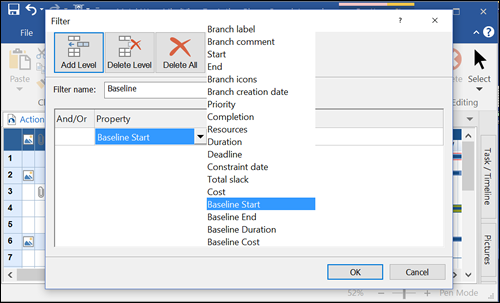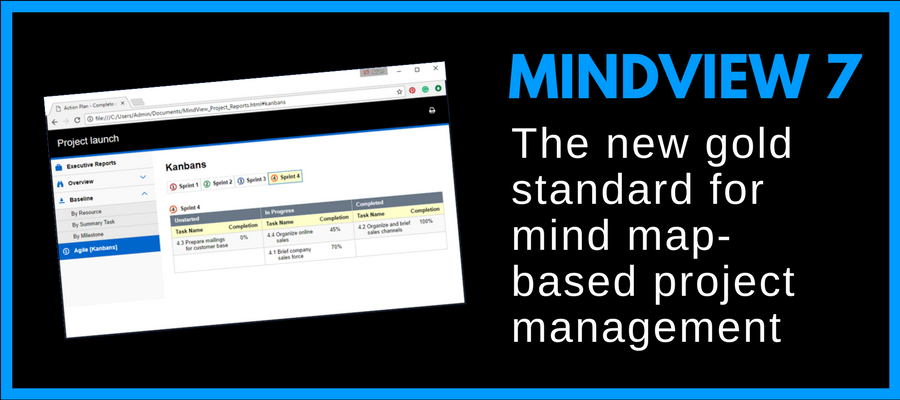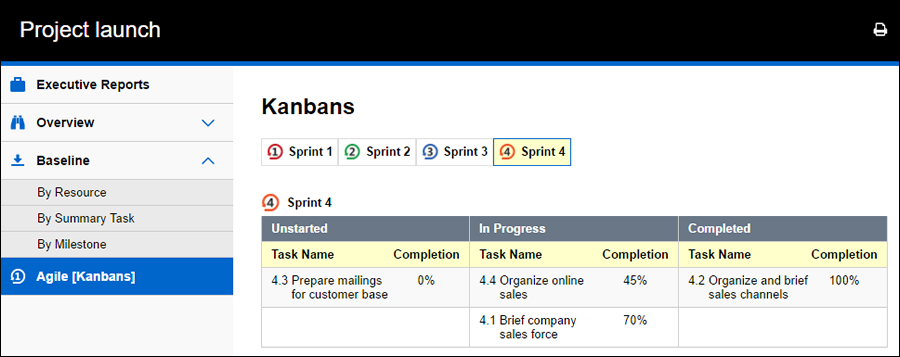Is MindView 7 de nieuwe standaard in mindmap-gebaseerd project management?
MindView 7, recently launched by Matchware for PC and Mac, sets a new standard for advanced project management within a mind map environment. It also offers dozens of updates and enhancements that make this one of best mind mapping software programs available today.
MindView 7 improves the program in so many big and little ways that are practical, not frivolous. In recent years, I have reviewed software programs that are a victim of feature bloat. In other words, they contain new features that sound cool, but mean little or nothing to the average user.
Matchware prides itself on being customer focused, and that comes through loud and clear as we take a close look at the new and improved features of version 7 of its flagship visual thinking program.
Advanced project management capabilities
MindView has taken the lead in advanced project management functionality for mind mapping software. Here are some of its latest advances in version 7:
Resources and loading: Resource management is based on the actual percentage of time a resource is devoted to a project, not an arbitrary 100% loading, as some programs assume. Matchware calls this “effort-based resource allocation,” which is consistent with how Microsoft Project describes it.
 Baselining helps you keep projects on track: Baselining is a new concept that enables users to determine how much the schedule of your project is slipping, and where the slippage is occurring. Basically, once you have organized your project, you take a baseline view of it, which is something like a snapshot. During project execution, you can take another baseline and compare the two. Initially, you’re given a high-level view of where the slippage has occurred, but you can drill down into the details to see exactly where the challenges or scope creep are occurring.
Baselining helps you keep projects on track: Baselining is a new concept that enables users to determine how much the schedule of your project is slipping, and where the slippage is occurring. Basically, once you have organized your project, you take a baseline view of it, which is something like a snapshot. During project execution, you can take another baseline and compare the two. Initially, you’re given a high-level view of where the slippage has occurred, but you can drill down into the details to see exactly where the challenges or scope creep are occurring.
Baselining sounds like such a simple concept, and it’s certainly not a new one in the world of project management. But I predict it will have a profound effect on the way that professional project managers use MindView. The ability to zero in on variances can help you get a project back on track faster.
Baselining can also help you improve estimating for future projects: For companies that tend to manage the same type of project over and over, it provides a way to compare current and past projects side-by-side to look for patterns in scope creep and schedule slippage. This type of analysis can help them to modify their processes so that future projects will proceed more smoothly.
GANTT enhancements: MindView 7’s GANTT view provides greater flexibility than ever; you can now add any field related to resources, costing and other variables as columns in the chart. This ability to customize it with key information you want to see (while also hiding non-essential data) significantly increases the value of GANTT view in version 7.
Effort-driven tasks: MindView 7 now accommodates three types of effort-driven tasks:
- Fixed units, in which the task duration is increased as resources are added
- Fixed work, which defines a period of time during which a certain number of hours of work may be performed and
- Fixed duration, which sets the amount of time a task takes, regardless of the amount of effort it requires.
Other new and enhanced MindView 7 features
 Microsoft office 2016 interface: MindView 7 now utilizes the Microsoft Office 2016 toolbar, with large icons and its new “show me” search field, which you can use to quickly find program functions if you don’t know where they’re located within the nested ribbon toolbar. I tried this feature, which sits just above the ribbon toolbar, and found it to be a quick and easy way to jump to even the most obscure program functions.
Microsoft office 2016 interface: MindView 7 now utilizes the Microsoft Office 2016 toolbar, with large icons and its new “show me” search field, which you can use to quickly find program functions if you don’t know where they’re located within the nested ribbon toolbar. I tried this feature, which sits just above the ribbon toolbar, and found it to be a quick and easy way to jump to even the most obscure program functions.
Microsoft Word export: Past versions of MindView have offered a decent degree of flexibility when it comes to setting the format of mind map topics and subtopics when you export them to Word. I’ve always appreciated the program’s dual options: Export your mind map to Word using the program’s default settings, or customize the text font, size and other characteristics on a per-topic level basis.
MindView 7’s Word export offers even greater flexibility, including the ability to export to your own corporate templates. Any resources that have been added to your mind map, such as images, links and attachments, are embedded in the exported Word document. MindView 7 offers similar functionality when exporting from your mind maps to PowerPoint presentations.
I plugged in the pathname of a custom template I created for my job, and MindView exported my mind map using the settings it contained. Any time you can eliminate document reformatting is a win, in my book!
Enhanced calculation features: When you’re building a project map, MindView 7 now treats top-level topics as summary tasks. In other words, they contain the rolled up scheduling, resource, cost and other data from the topics below it in the map hierarchy. It’s nice to see that the program anticipates this need, rather than requiring you to individually modify each topic to support calculations.
The calculation capabilities of MindView 7 have been expanded to more closely mirror the functions of Microsoft Excel. If you are an Excel formula wizard, you will feel at home with this program’s calculation builder. What’s really cool is that MindView 7’s calculation engine not only handles numerical values, but also text values, for such concepts as risk management.
 Show/hide task data: MindView 7 now enables you to show or hide individual task fields beneath the topics of your project map. If you want a cleaner look, you can hide all of the data, or selectively display it in ways that make the most sense to you. It’s not an all or nothing option; it gives you a great deal of flexibility. If you’re working with a large, complex project map, I think you’ll appreciate the flexibility to adjust the level of detail you want to view.
Show/hide task data: MindView 7 now enables you to show or hide individual task fields beneath the topics of your project map. If you want a cleaner look, you can hide all of the data, or selectively display it in ways that make the most sense to you. It’s not an all or nothing option; it gives you a great deal of flexibility. If you’re working with a large, complex project map, I think you’ll appreciate the flexibility to adjust the level of detail you want to view.
Agile project management: This is where MindView 7 gets really cool; it now supports agile sprints, a core tenet of agile project management (why didn’t any other developers think of this until now?). The way it does this is quite elegant: the program contains a set of numbered priority icons that are specific to agile. This enables you to quickly assign specific tasks to different sprints within your agile project.
Once you have done so, you can then switch to an agile report view, which shows each sprint in a separate column, with the tasks assigned to it neatly displayed below it. This is very slick! Sprints are displayed in tabs across the top of the report, so you can look at each one, one at a time. Within a sprint, tasks are classified as not started, in progress and complete. The program adheres closely to kanban methodology, making it a real asset for organizations that are already utilizing agile project management.
Branch connections labels: This new feature enables you to make more explicit the relationships between topics in your mind map. Just as in a concept map, branch labels let you specify HOW the two topics are related.
Enhanced timeline view: The timeline view, which is been exclusive to MindView for the last several versions, has been enhanced in version 7 with new styles and layouts, making it even more useful and attractive as a way to share time-based information with others.
Publish and share mind maps: The Matchware website now contains a mind map gallery, where you can publish your maps, either to be downloaded and used by others as templates or on a private basis if you want to share mind maps with colleagues who do not have MindView.
Conclusion
Thanks to its steady pace of improvement, MindView has inherited the mantle of the best project management toolset of any mind mapping program, a distinction once held by MindManager.
MindView’s project management features are quite impressive, and anticipate all of the things that professional project managers need to track – namely, tasks, people and budgets. Its features and capabilities continue to grow, yet remain easy to use. MindView’s support for agile project management is a big plus, and should broaden its popularity into firms that are committed to this methodology.
If you’re not a project manager, MindView 7 still has plenty to offer, especially if you tend to work with large, complex mind maps. It enables you to selectively show or hide branch data and does so with a surprising level of granularity – so you can quickly display the branch data you need at any given moment and hide the rest.
Matchware is also concerned about what users of its software do AFTER they have produced a mind map. That’s why it has paid so much attention to making its Microsoft Office export tools as flexible as possible.
If you’ve ever used another mind mapping program to export a map to Microsoft Word, then you know how much tweaking you need to do to topics and notes to make them look presentable. MindView 7’s ability to handle the export to Word via YOUR templates is brilliant, and will be a big time-saver for its users!
MindView 7 is available from the Matchware website; this web page summarizes all of the new and improved features of this impressive program. A single-user license for MindView 7 PC is US$379; the Mac version is US$349. Upgrade pricing is available for owners of previous versions of the program: Matchware gives a 40% discount to version 6 users, and a 20% discount to version 5 users.

